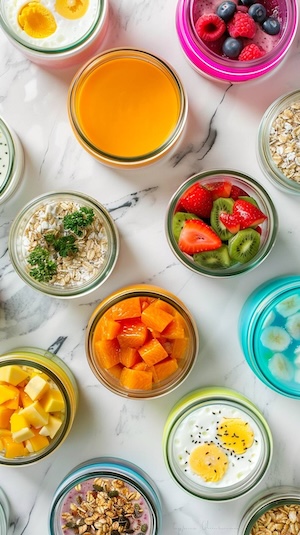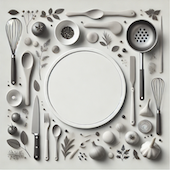PCOS for Picky Eaters: 30 Simple Meal Ideas
Discover 30 simple pcos meals for picky eaters that help manage symptoms. Easy pcos meals picky eaters will love, with practical tips and hormone-balancing ingredients.
Recipe by Charles Phan Dried rice noodles are readily available, but homemade fresh noodles are a fun project. If you've ever made the light pastry dough known as pâte à choux (the base for gougères and profiteroles), the first step to making the noodle
Transform your health with tailored 7-day meal plans designed specifically for PCOS management. Just $7/month or $59/year.
Get it now →4 cups rice flour, plus more for dusting
3 1/2 cups water
3 tablespoons shallot oil or canola oil
1 cup tapioca starch
In a bowl, whisk together the rice flour and 3 1/2 cups water until smooth. Cover and allow to ferment at room temperature for 4 days.
Carefully pour out 1 1/2 cups water from the settled rice flour. Add 1/4 cup fresh water to the batter and stir until smooth.
Bring a large stockpot of salted water to a boil over high heat. Keep the water hot while you prepare the dough.
In a heavy-bottomed 4- to 6-quart pot, heat the oil over high heat. When the oil is hot, add the batter and turn down the heat to low. This is a two-person job: one person needs to stabilize the pot while the other one quickly and firmly stirs the batter with a wooden spoon. The dough will begin to thicken. Continue cooking, stirring continuously, for 5 to 8 minutes, until the dough is a thick, firm paste. If any dough sticks to the sides of the pot, do not scrape it off.
Transfer the dough to a stand mixer fitted with the dough hook and add tapioca starch. Mix on medium speed for about 10 minutes, until it forms a sticky ball.
Bring the water back to a boil, then adjust the heat to keep it at a vigorous simmer. While the water is heating, dust a clean work surface with flour, transfer the dough to it, and knead for another 5 minutes, until smooth. Cover the dough with plastic wrap to prevent it from drying out.
Prepare a large ice-water bath and place it near the stove. Put 1 1/2 cups of the dough into a potato ricer, keeping the remaining dough covered. Position the ricer directly above the center of the pot of boiling water and press firmly to extrude the noodles. As you press, smoothly lower the ricer close to the water and shake it gently from side to side to break the ends of the noodles free, allowing the noodles to fall into the simmering water. Simmer the noodles for 1 1/2 to 2 minutes, until they bunch up to one side of the pot. With a spider or tongs, carefully transfer the noodles to the ice-water bath. Once cool, transfer to a colander and let drain. Repeat with the remaining dough, replacing the ice water as needed. When all the noodles have been cooked and cooled, rinse the noodles under cold running water to remove excess starch. Drain the noodles. The noodles are best used the same day they are made, but they can be covered and refrigerated for up to 1 day.

You know the drill: Alarm goes off. You hit snooze. Rush around frantically. Skip breakfast AGAIN because there's no time. By 10am, you're hangry, your blood sugar is all over the place, and your PCOS symptoms are already acting up.
Sound familiar?
Finally – a meal prep system designed specifically for women with PCOS who refuse to let chaotic mornings derail their health goals.
In just ONE hour on Sunday, you can transform your entire week:
"I went from skipping breakfast 4 days a week to having delicious, hormone-supporting meals ready every morning. My energy is more stable and my cravings have disappeared!"
– Sarah M.
Stop letting chaotic mornings control your health.
Get your hormone-happy mornings starting this Sunday.
→ Get Your 60-Minute Solution Now
Transform your health with tailored 7-day meal plans designed specifically for PCOS management. Just $7/month or $59/year.
Get it now →Serving Size: 0
| Amount Per ONE Serving | ||
|---|---|---|
| Calories 0 kcal | ||
| Fat 0 g | ||
| Carbohydrate 0 g | ||
| Protein 0 g | ||
💡 Introducing the 10/10 PCOS Solution:
Ten Delicious Crockpot Recipes that take just 10 minutes to prep!
Say goodbye to hours in the kitchen and hello to clean, PCOS-friendly meals made effortlessly.
👉 Click here to grab your 10/10 PCOS Solution today! Try The 10/10 PCOS Solution: Ten Crockpot Recipes That Take Just Ten Minutes to Prep
Managing PCOS can be challenging, but you don't have to do it alone. Join our supportive community to connect with others who understand what you're going through, share tips, and get encouragement. Here's how you can get involved:
Subscribe to our Newsletter: Receive PCOS-friendly recipes, tips, research updates, and more delivered straight to your inbox. Stay informed and empowered with the latest information and support.
Join our Telegram Channel: Stay updated with the latest tips and advice on managing PCOS.
Follow PCOS Meal Planner on Facebook: Engage with our community, participate in discussions, and get support from others.
Break the cycle with the PCOS Meal Planner - your personalized guide to eating better, feeling better, and managing PCOS symptoms. Take control today!

Forget the frustrating cycle of weight loss attempts, endless medications, and living in discomfort. Introducing the PCOS Meal Planner. A meal planning guide that goes beyond temporary fixes to offer a comprehensive strategy, empowering you to ignite a transformation towards lasting health and happiness. Step into a world where you control your PCOS, not the other way around.
Unlock Your PCOS Freedom Now.
Discover 30 simple pcos meals for picky eaters that help manage symptoms. Easy pcos meals picky eaters will love, with practical tips and hormone-balancing ingredients.
Discover 15 delicious overnight oats for PCOS recipes that help balance hormones and manage symptoms. Easy, nutritious breakfast ideas perfect for women with PCOS.
Discover the best cereal for PCOS with our expert rankings. Compare brands, check ingredients, and find PCOS friendly cereal that supports hormonal balance.
Learn how to transition away from fruit when starting a ketogenic diet for PCOS. Discover gradual strategies, fruit alternatives, and practical tips for success.
Discover 5 delicious PCOS banana bread recipes with low-glycemic ingredients. Learn how to make hormone-friendly banana bread that supports blood sugar balance.
Creatine for women with PCOS explained simply. Learn safety, benefits, hormone effects, tips, and how creatine may support PCOS symptoms naturally.
Complete PCOS diet plan with foods to eat, foods to avoid, meal timing, and real results. Learn the science-backed approach to managing PCOS through diet, with 7-day meal plan, grocery list, and step-by-step implementation guide. Based on clinical research and real patient outcomes.
Complete guide to ordering at Wendy's with PCOS. Discover the best protein-focused meals, what to skip, and how to customize orders to keep blood sugar stable. Learn which burgers, salads, and sides work for PCOS, plus complete macros for every menu item and smart swaps to avoid insulin spikes.
Complete guide to ordering at Burger King with PCOS. Discover the best protein-focused meals, what to skip, and how to customize orders to keep blood sugar stable. Learn which burgers, salads, and sides work for PCOS, plus complete macros for every menu item and smart swaps to avoid insulin spikes.